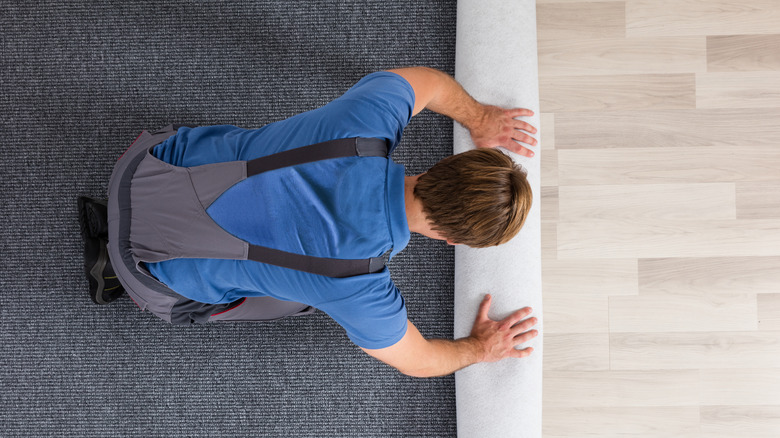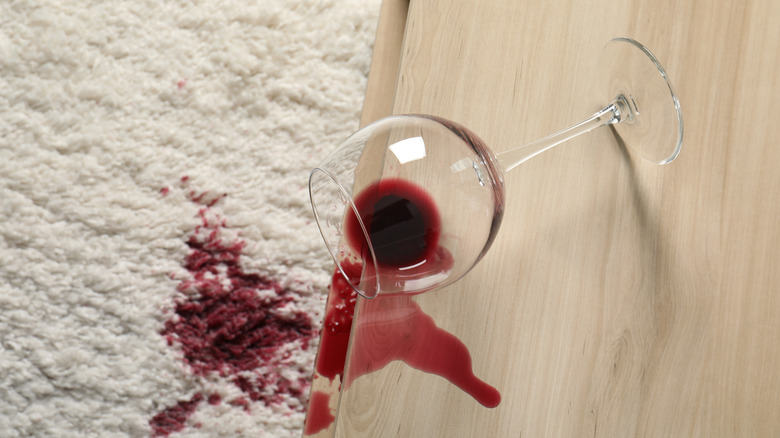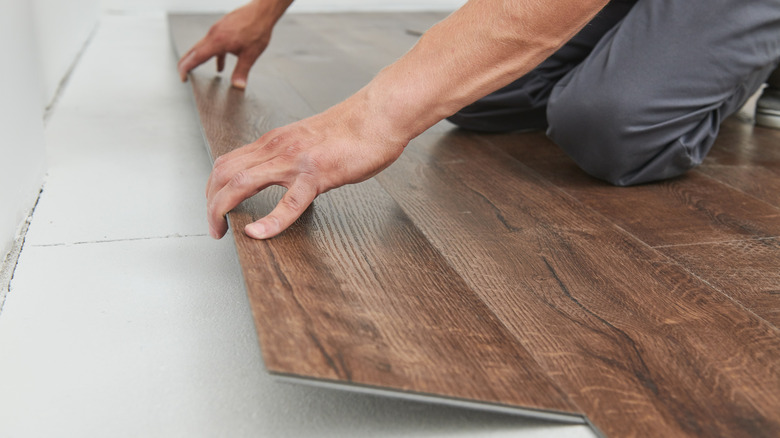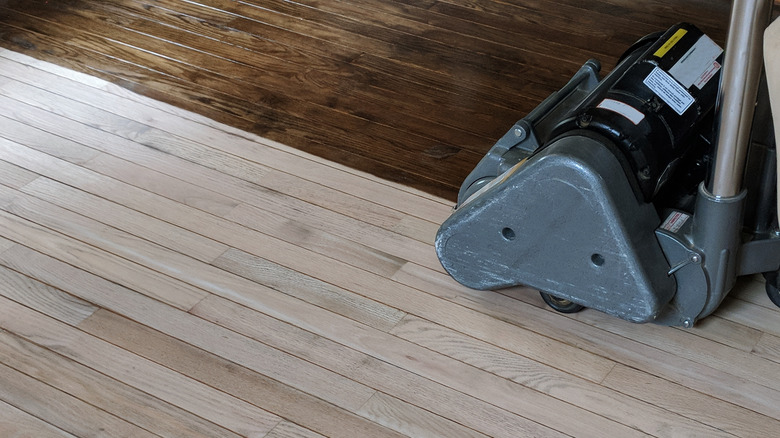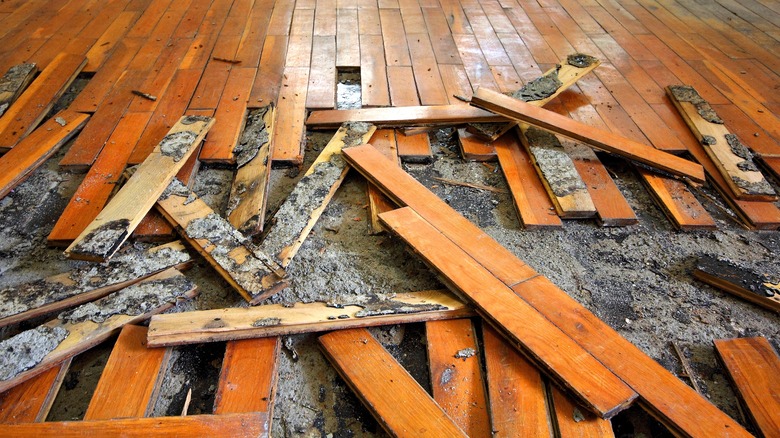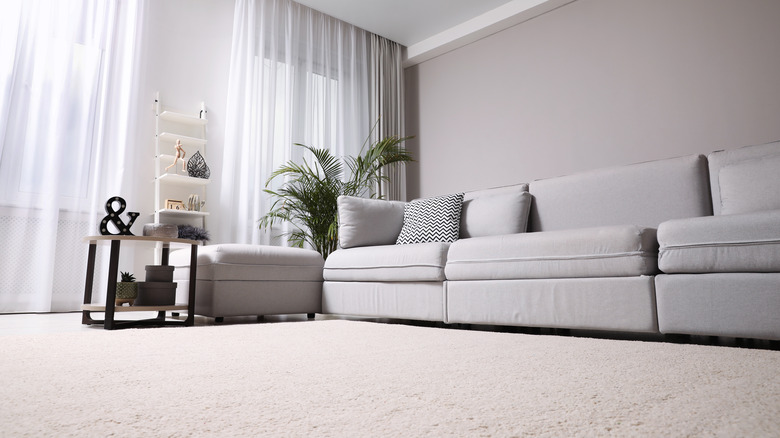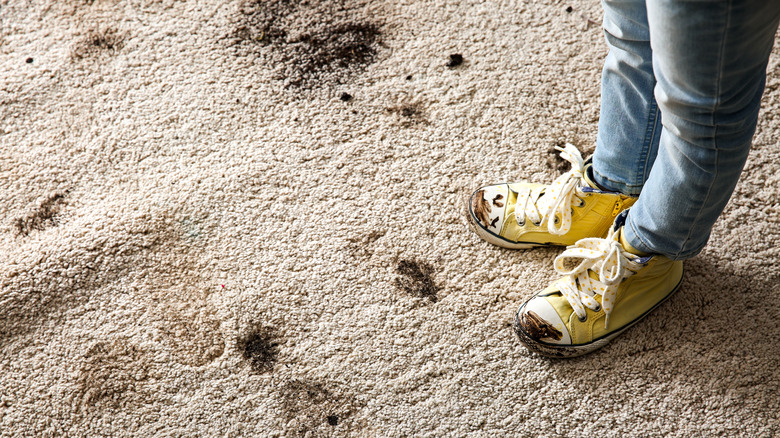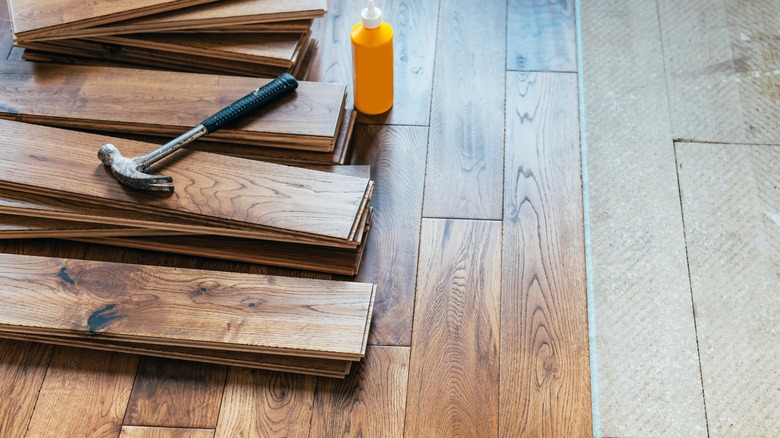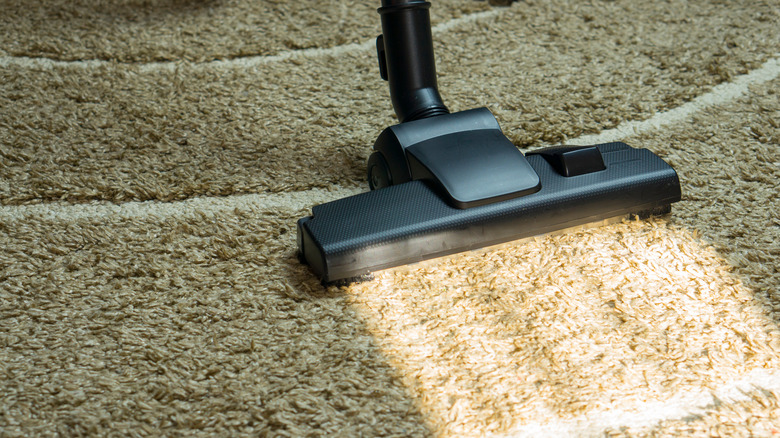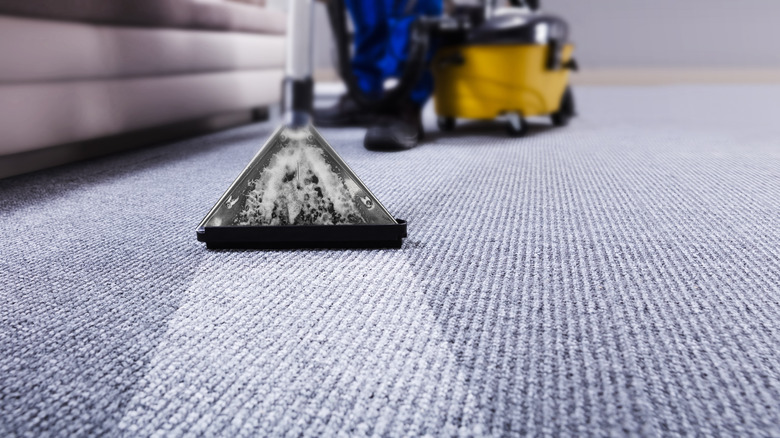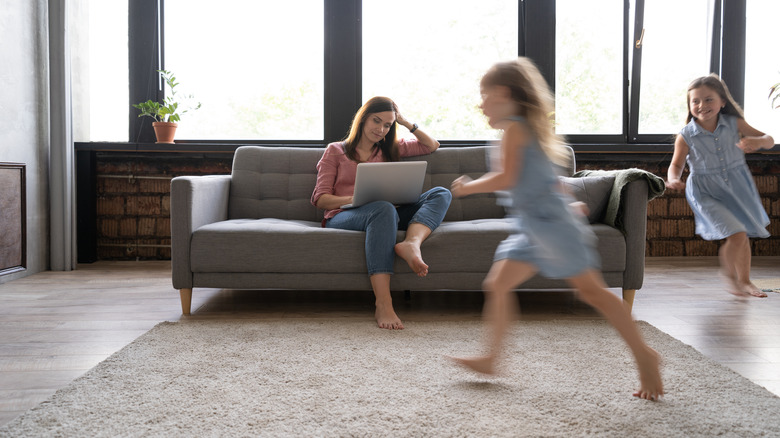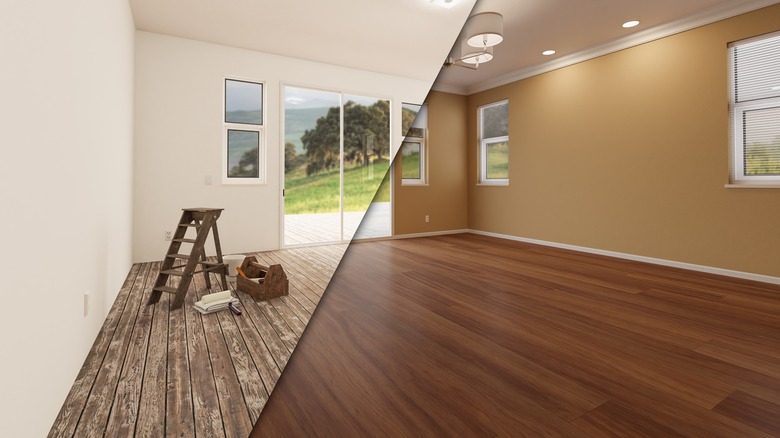Wood Floors Vs. Carpet: Pros And Cons Of Both
With the possible exceptions of popcorn ceilings and phrase art (such as the self-referential classic "it's okay to make bad art"), there's not much more settled in the world of interior design than the superiority of hardwood flooring over carpet. But nothing topples quite so readily as a settled matter. If it's a design article of faith that carpet is bad and bad for you, it's a contrarian article of faith that looking at things a different way can undermine any orthodoxy. Not only is carpet sometimes desirable, but it brings some qualities to the table that hardwood simply can't. But we'll get to that.
You should probably start by taking a hard look at what you want and expect from your floors. At a minimum, you'll want to consider Consumer Reports' areas of concern: looks, cost, and durability. Also, consider areas such as physical comfort, noise reduction, and your home's resale value. And let's not forget instincts. We often have preferences we can't fully explain, and we might feel dissatisfied if we make a choice without respect to that instinct.
Conventional wisdom might be more conventional than wise
So what exactly does conventional wisdom tell us about the wood versus carpet debate? First and foremost, that carpet is bad for your health. (This argument alone, understandably, tends to trump any positives about carpet.) Most believe that carpet is more difficult to maintain and, in general, more expensive to own. All its advantages (quietness, softness, etc.) can be replaced with a rug or two dropped on top of more stylish hardwood floors.
But it hasn't always been like this, and subjective opinions have a way of changing over time. And some forces — particularly, all that time we spent at home during COVID lockdowns — have started shifting opinions in the carpet vs. wood debate. "Carpet is still very relevant in the flooring decision process," Heather Yamada of Shaw Industries told Floor Trends. "People are seeking out carpet and it has a lot of benefits especially in what we call our COVID world."
We'll explore and challenge some of this conventional wisdom below.
It depends on what the meaning of the word wood is
Before we can resolve the carpet-wood debate once and for all to everyone's perfect and permanent satisfaction, we must first look at what we mean by "wood." This would seem simple enough: Wood is made of wood, and since it's also called "hardwood," we can assume it's reasonably hard. The trouble is that neither of those things is necessarily true. "Hardwood flooring" can describe pine, which is famously soft, or laminate flooring (fiberboard with a picture of wood printed on a durable surface called a "wear layer," according to Flooring Inc.), which is often grouped with engineered flooring. Engineered hardwood is a veneer of hardwood atop a base of dimensionally stable plywood.
Online retailer Hardwood Floor Store, which touts engineered hardwood, has a detailed overview of wood and wood-like flooring options. They all generally perform similarly to solid wood. Nothing can be refinished as many times as real wood, of course. And laminate flooring, perhaps the one flooring type that doesn't belong in consideration alongside wood, is generally less attractive, less durable, and far more susceptible to water intrusion.
For our purposes here, we are comparing carpeting to the characteristics of solid hardwood, which are often shared by these other wood products.
Wood pros: The flooring is the ceiling
The traditional thinking about hardwood involves a long list of pros, and these are largely correct. According to Realty Times, hardwood has advantages over carpet in durability, resale value, health attributes, and maintenance and repair, if you take the long view.
The durability of hardwood is largely a function of its very long life and its ability to be refinished many times. So, take note that some engineered hardwoods can only be refinished once (via 50 Floor), and laminate flooring can't be refinished at all. If you could rejuvenate your carpet by removing one-sixteenth inch or less of its height (the maximum amount of wood removed during refinishing), we'd probably view carpet as equally durable.
But some of these pros aren't as clear-cut as we've long believed. We'll dig into a few of the particulars below, but in broad terms, questions have arisen about whether hardwood is actually better for suppressing toxins and allergens. Research has shown that, in some circumstances, carpet does an even better job. On the other hand, hardwood's contribution to resale value is a long-standing trend and can't really be questioned ... yet.
Wood cons: The downsides of underfoot hardwood
Hardwood flooring does have some potential downsides. Aside from the initial expense of installation ($4,556 on average, according to HomeAdvisor), and while hardwood does enjoy some long-term maintenance savings, severely damaged hardwood floors could be extremely expensive to repair, or could require outright replacement. Since the economy of hardwood flooring relies on its longevity, this advantage gets completely erased when the flooring is irreparably damaged. This might sound like a big "gotcha," but it's the way everything works — if you had to buy a new car after six months, cars would suddenly become prohibitively expensive to own. And the advantage is meaningful: Carpet is an extremely expensive thing to have to replace every 15 years ... though certainly not as expensive as a car.
But hardwood does have some comparative disadvantages. Certain finishes and softer woods can scratch easily (as can some laminates and engineered wood), says Realtor.com. Refinishing wood floors is a pricey undertaking, quite a chore, or both. Most importantly, hardwood is very sensitive to moisture, which can cause catastrophic damage quite easily. This is particularly true of hardwood that isn't installed correctly, according to manufacturer recommendations.
Carpet pros: The hard truth about soft flooring
Whatever your favorite home remodeling show might have told you, carpet does have its fans and some distinct advantages over hardwood. According to Houselogic, it's significantly cheaper to install, and far easier if you choose to install it yourself. It has superior sound-absorption properties, which can only be approximated in wood flooring with expensive, over-engineered solutions. And, obviously, it's softer. This last trait can be an advantage in lots of situations, but particularly if you have children, and even more so if you end up on the floor playing with those children.
But wait, there's more. Houselogic argues that the range of color and materials makes it a good choice for design flexibility, and that modern carpets can be less toxic, and more eco-friendly, than the carpets of yore. Don't get too carried away with claims about hardwood's health superiority; as we mentioned, there have been questions about that.
Carpet cons: Dirty secrets about the wooly world of pile
Of course, carpet didn't get its poor reputation without having a few issues, and those mostly vary according to the fiber a particular carpet is made from, per Maple Leaf Realty. Carpet's comparatively difficult to clean, and arguably impossible to clean thoroughly. (Ask anyone who's ever removed carpeting; the amount of stuff that collects in and under it is disturbing, and there are quite a few allergens lurking in those dust drifts.) Carpet is not very durable, needing replacement in as little as one-tenth the time of hardwood. And carpet tends to capture stains and smells.
Another disadvantage is carpet is relatively less compatible with underfloor heating systems than hardwood ... although Continal Underfloor Heating points out that some less insulative carpets will work fine with underfloor heating (as expressed in tog, or Thermal Overall Grade, ratings). If you go this route, work with a reputable installer for underfloor heating, and make sure the heating in carpet and uncarpeted rooms is adjusted appropriately.
Resale value: How will flooring decisions impact long-term investment?
Perhaps the best place to start discussing improvements to your house involves talking about how you'll get rid of it ... eventually. Resale value is a strategy for recouping costs for home improvements. It is an investment perspective: You are concerned about the return you'll get on your investment in flooring.
Either way, there's a clear winner in this area in almost every regard, according to the National Association of Realtors (NAR): hardwood floors, with a 70-80% return on investment. Most home buyers will pay more for a home with hardwood than with carpet. NAR's 2022 Remodeling Impact Report shows that refinished hardwood floors enjoy a 147% cost recovery (the amount of cost that is recouped when the home is sold). New hardwood floors provide a 118% cost recovery. Both of these numbers are higher than investments in insulation, attic and basement conversions, kitchen and bathroom renovation, or anything else analyzed.
The problem with resale value is that it doesn't measure, in any way, what will make you happy while using the flooring. If you need quiet or want an aging pet to be more comfortable, that might trump a few hundred or a couple thousand dollars in resale value.
Cost: The biggest factor we don't want to think or care about
The first half of the investment equation is, of course, cost. What is the amount of the investment itself? You calculate your return based on this initial investment. Carpet costs less to install, and if that's all you can afford at a given time, that's all the information you need. Choose wisely, because costs are driven up by unexpected flooring failures, often caused by selecting the wrong material for a particular area, says FacilitiesNet.
Carpet hands-down wins this category. The carpet itself can cost $1-11 per square foot, while hardwood will run between $3-14. Don't forget the padding, which can run $3-4 per square foot, according to Thumbtack's flooring cost guide. Carpet has an average installation cost of $8.71 per square foot ($1,220 for 140 square feet) of nylon carpet, via Fixr, versus $20.10/square foot ($4,020 for 200 square feet) of hardwood.
Health: Is your floor trying to kill you?
Matters of health are where, as usual, things get a little unclear. It's long been conventional wisdom that carpet traps particles that aren't healthy. The American Lung Association lists "pollutants like dust mites, pet dander, cockroach allergens, particle pollution, lead, mold spores, pesticides, dirt and dust" can be trapped in carpets, and adds that toxic gasses "can stick to small particles that settle into carpets." In most cases, that appears to remain true, though a 2008 review by the National Center for Healthy Housing says a few research studies have shown "airborne dust levels can actually be lower in carpeted rooms as compared to non-carpeted rooms. This unusual finding has been observed in situations where the carpet has been maintained with an aggressive vacuuming schedule."
Ultimately, the NCHH found it is still, on balance, better to avoid carpeting in rooms occupied regularly by allergy or asthma sufferers. A 2018 review in the International Journal of Environmental Research and Public Health found no reason to be less cautious with carpet based on research or manufacturer claims.
Another health concern with carpet is the hazardous volatile organic compounds present during manufacturing, which can be released into the air during and after installation of carpets, carpet pads, and adhesives. Look for carpeting with reduced VOCs.
Safety: If glass breaks on it, won't your head too?
Physical safety, aside from health issues, might seem like a minor discussion about flooring, but when you take a tumble, you'll be thankful if the floor is forgiving. This is particularly true if you're a child or an older person. Esther Kane at Senior Safety Advice attributes this to both the softness of carpet and the slipperiness of other materials, but warns that plush, worn, or improperly installed carpet can present a tripping hazard.
Flooring choice has particular safety considerations when you're flooring your stairs. Carpet's detractors sometimes mention that carpet can eventually be dislodged and become a tripping hazard, particularly on stairways, but the same thing happens with wood floors, according to Fairmarket Home. The Los Angeles Times advises you to avoid covering stairs with carpeting that includes built-in padding. Senior Safety Advice ultimately recommends carpeting on stairs, but cautions that runners can create balance problems for seniors, and carpeting can further reduce the depth of shallow steps, making them more difficult to navigate safely.
Maintenance and total cost of ownership
The issue of cost has several dimensions. Of course, you want to know the immediate out-of-pocket expense involved in purchasing and installing your floor. Another dimension is time: How much does carpet versus hardwood cost over the life of a floor (or a different floor, or you)? U.K. manufacturer Birch Carpets estimates that well-cared-for hardwood can last 100 years, while properly maintained carpet lasts about 15. Also, what expenses are involved in maintaining and repairing the floor, and how often must it be replaced?
Unique Wood Floors estimates that the basic cost of hardwood and carpeting are roughly similar over a 30-year period in which the hardwood is refinished twice and the carpet is replaced twice. Of course, total cost of ownership also includes repairs and maintenance, but hard figures for those costs are hard to come by. That's where the International Journal of Life Cycle Assessment comes to the rescue. A 2015 cost assessment for residential flooring options found that maintenance is a huge part of the total cost of ownership of flooring, making up 49% of hardwood floor costs and 30% of total carpeting costs. This strongly suggests that, however much easier hardwood might seem to maintain, it's unexpectedly expensive.
Sound: Why you should consider carpeting absolutely everything
There is probably no single area in which either carpet or hardwood flooring stands out the way carpet proves itself superior in absorbing sound. You must consider sound traveling through solid materials, as from an upstairs floor, as well as the way sound reflects in the space you're in. You also probably want to think about sound produced by the floor itself, such as squeaking and creaking.
If your resources are limited, and suppressing sound is a great concern, you should probably consider installing a high-pile carpet as your best option, says Soundproof Central. There are sound isolation products that can help with hardwood flooring, like mat underlayment specifically designed for the purpose (per All American Flooring), but these tend to be expensive and can be difficult to install. There are also sound boards that can be installed beneath your subfloor, but that's better left to new construction and major remodels.
All of this sound suppression is measured in ICC ratings (for impact sounds) and STC ratings (for airborne sounds), via All Things Flooring. Carpet always comes out on top, but if you use these ratings to compare other materials, keep in mind that ICC and STC measurements have some serious drawbacks, including not dealing with parts of the audible spectrum, and disguising deficiencies at a certain sound frequency by averaging all frequencies into the final score (via The Construction Specifier).
Consumer preferences: What you care about more than anything else
In a lot of cases, the thing about all these factors is that they don't matter. Or, more specifically, that you don't care about them nearly as much as you care about your personal, sometimes instinctive preferences.
In a 1969 US Forestry Service report, a report so old it blithely compares vinyl asbestos tile to hardwood and carpet, hardwood was found to have slightly higher installation costs but far lower total cost of ownership, largely because carpet had to be replaced every 7.5 years, where hardwood was only refinished every 9.5 years at a price far lower than a full new installation. Many of the floors investigated in this study were installed 15 years before, so none of the numbers originating almost 70 years ago are reliable. It's unlikely that maintenance time and costs shifted dramatically enough to invalidate the findings, but what is most interesting is the difference between the findings and the flooring opinions sought from "housewives" (this report is, indeed, from a different era). These opinions often differed remarkably from the data they provided, and the one emerging pattern was that homeowners have a significant bias toward whichever material they already have in their homes.
Of course, it's not all about individuals' preferences. In NAR's 2019 Remodeling Impact Survey, the results of remodeling were evaluated about the same by homeowners and realtors, which is unlikely if the options and outcomes were entirely driven by homeowner preference.
So what do I do with all of this conflicting info?
You should look at your flooring choices in a couple of tiers, understanding the importance of each. Let's say the first is expense: You can afford what you can afford, and that might limit your choices outright. The second might be your preference, which has the potential to trump any other factors if the preference is strong enough. Then there are major considerations like health and safety issues, matters important enough to overrule your preferences and maybe even cause you to creatively finance a floor you can't really afford. Then there are comfort and style matters: Which is comfortable for kids, or to play with kids on? Will pets be comfortable? Is it quiet enough for your sleeping, research, or daily decompression habits? Does it keep up with the Joneses?
Some criteria that seem important hardly register on this hierarchy of flooring needs. The advantages of consistent flooring throughout a home, at least in the context of flipping or otherwise selling a home, should give way to the "Goldilocks approach" of finding a happy middle ground, says Debbie Gartner, The Flooring Girl.
Really, it's all about the happy, middle ground. Consumer preference versus resale value, comfort versus style, expense versus return on investment ... each are opportunities to optimize everything by not quite optimizing anything in particular. Maybe pick some rooms to carpet and some rooms to floor in hardwood, then move on to the next homeowner adventure.
